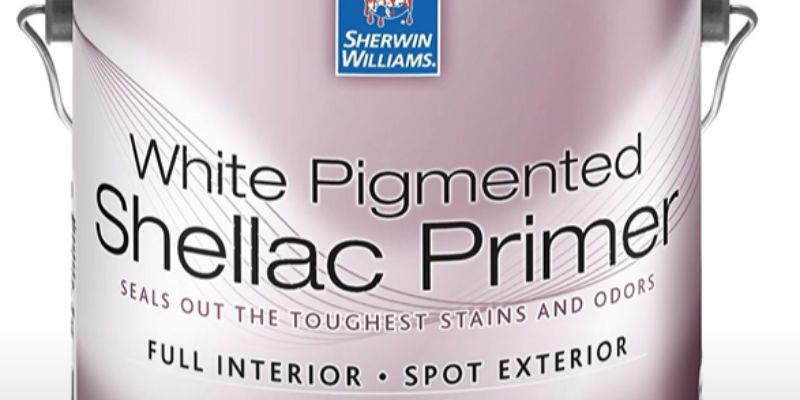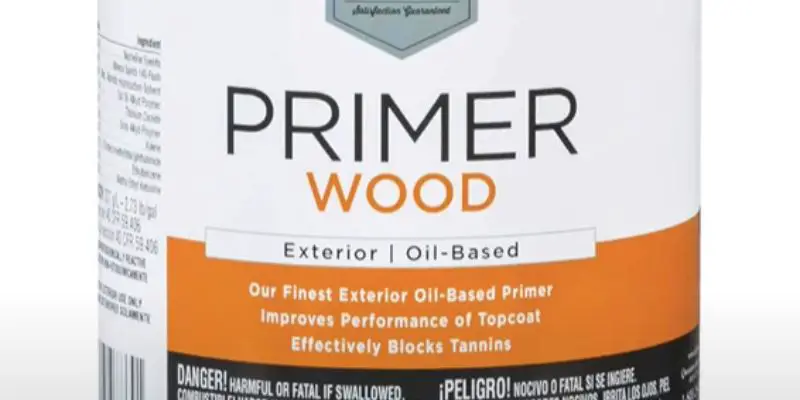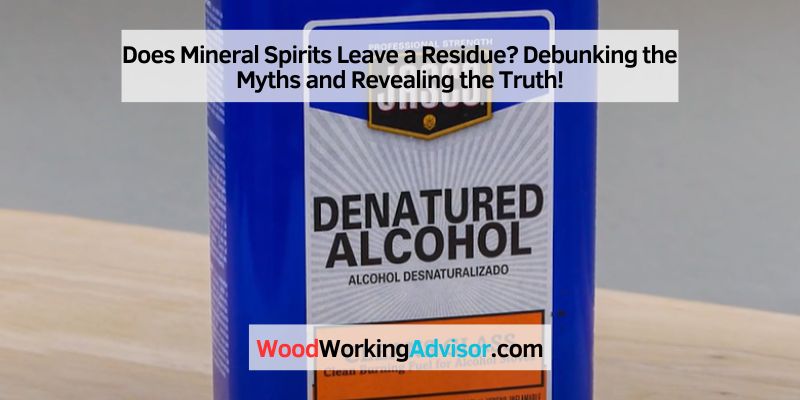No, mineral spirits do not leave a residue. Mineral spirits evaporate completely, leaving behind no residue or film.
Mineral spirits, also known as white spirits or paint thinner, are commonly used as a solvent for cleaning and degreasing purposes. They effectively dissolve oil-based paints, varnishes, and other substances, and when used properly, they do not leave any residue behind.
This makes mineral spirits a popular choice for cleaning tools and surfaces without the worry of leaving an unwanted film or residue. Additionally, mineral spirits are low in toxicity and have a relatively low odor, making them a preferred option for many DIYers and professionals alike.
What Is Mineral Spirits?
Mineral spirits are a type of solvent commonly used in various industries and households. Also known as white spirit or paint thinner, it is a petroleum-based liquid that is clear and colorless. Mineral spirits is a versatile substance that offers powerful cleaning and degreasing properties, making it a popular choice for tasks such as removing paint, stains, and varnishes.
Composition
Mineral spirits are comprised of a mixture of hydrocarbons, typically obtained from crude oil refining. The composition can vary slightly depending on the specific brand or manufacturer, but the general makeup remains consistent. It primarily consists of aliphatic, aromatic, and naphthene compounds.
These hydrocarbons work together to dissolve and thin out substances such as paints, greases, and oils with ease, making them easier to remove or clean. Mineral spirits have a low volatility and evaporate relatively slowly, ensuring they remain effective for longer periods.
Common Uses
Mineral spirits find a wide range of applications in various industries and households, thanks to their excellent solvent properties. Here are some of the most common uses of mineral spirits:
- Cleaning and Degreasing: Mineral spirits are widely used as a cleaning agent to remove dirt, grime, and grease from surfaces, tools, and machinery. It effectively cuts through oil-based substances, making it ideal for cleaning automotive parts, engine components, and metal surfaces.
- Paint Thinner: Due to its ability to dissolve paints and varnishes, mineral spirits are often used as a paint thinner. It helps to thin out the consistency of oil-based paints, making them more manageable for application while also cleaning up brushes and other painting equipment.
- Adhesive Removal: Mineral spirits can effectively remove adhesive residue left behind by stickers, labels, or tapes. Its dissolving properties make it a handy solution for safely removing sticky substances from surfaces without causing damage.
- Wood Treatment: When used in woodworking, mineral spirits help in cleaning and preparing surfaces by removing any existing finishes or contaminants. It also aids in conditioning and restoring the natural appearance of wood, making it a vital part of the wood treatment process.
These are just a few examples of the versatility and usefulness of mineral spirits. Its ability to dissolve and clean a wide variety of substances makes it an essential product in many industries and a go-to choice for DIY projects.

Debunking The Myths
When it comes to using mineral spirits as a solvent, there are a few common misconceptions that often leave DIY enthusiasts and professionals alike scratching their heads. In this section, we will dive deep into these myths and provide you with clear, concise answers.
Myth 1: Leaves A Residue
One of the most persistent myths surrounding mineral spirits is that they leave a residue after use. However, this couldn’t be further from the truth. Mineral spirits, also known as paint thinner, are specifically formulated to evaporate quickly and leave no trace behind.
Unlike other solvents, mineral spirits do not contain any oily substances or additives that can contribute to residue buildup. When used properly and in the recommended amount, it simply dissolves dirt, grease, and other contaminants, allowing them to be wiped away easily.
In fact, mineral spirits are often used as a final cleaning step in various projects, ensuring a clean and residue-free surface. Whether you’re cleaning brushes or removing stains from wood, this solvent is your go-to solution.
Myth 2: Harmful To Surfaces
Another misconception surrounding mineral spirits is that they can be harmful to surfaces. While it is true that some solvents can damage certain materials, mineral spirits are generally safe to use on a wide range of surfaces, including wood, metal, and plastic.
Mineral spirits have a low toxicity level, making them a preferred option for cleaning and degreasing purposes. They are designed to be gentle on surfaces while effectively removing stubborn stains and grime.
It is important, however, to always test the solvent on a small, inconspicuous area before applying it to the entire surface. This precaution ensures compatibility and prevents any potential damage.
Moreover, using mineral spirits correctly is essential. Always follow the manufacturer’s instructions, wear protective gloves, and work in a well-ventilated area to ensure safety at all times.
In conclusion, mineral spirits do not leave a residue and are generally not harmful to surfaces when used properly. Debunking these myths will help you confidently use this versatile solvent for your cleaning and maintenance needs.
Understanding The Truth
When it comes to using mineral spirits as a cleaner, one of the concerns that users often have is whether it leaves a residue. Let’s uncover the truth and explore the potential residue that mineral spirits may leave behind.
Effectiveness As A Cleaner
Mineral spirits are known for their powerful cleaning properties, effectively removing grease, grime, and other tough stains from various surfaces. However, it’s important to use them sparingly as they can leave a residue if not properly wiped off.
Residue Potential
Although mineral spirits evaporate quickly, if not wiped away completely, they can leave a thin film or residue on the surface. This residue may not always be visible to the naked eye, but it can accumulate over time, affecting the appearance of the surface.
Best Practices
Mineral spirits generally leave a residue behind only if not wiped off properly. This can result in streaks and a dull appearance on surfaces. To avoid this, ensure thorough cleaning and complete evaporation of the mineral spirits before applying any finish.
Regular inspection and proper handling can help prevent residue buildup.
When it comes to using mineral spirits for surface cleaning or paint thinning, it is essential to follow certain best practices. These practices ensure maximum effectiveness and minimize the risk of leaving behind any residue.
Surface Preparation
Before using mineral spirits, proper surface preparation is key to achieving the desired results. Start by removing any loose dirt or debris from the surface using a soft cloth or brush. This step helps in preventing the residue from getting trapped under the newly applied finish or paint. Additionally, it allows the mineral spirits to penetrate the surface more effectively, ensuring a thorough cleaning.
For stubborn stains or heavy grime buildup, it might be necessary to apply mineral spirits directly to the affected area. Gently rub the surface using a clean cloth, working in circular motions. Repeat the process if needed, until the desired cleanliness is achieved. Once the cleaning is complete, thoroughly dry the surface before applying any finish or paint.
Proper Ventilation
Ensuring proper ventilation is crucial when using mineral spirits. These solvents can release fumes that may be harmful if inhaled in high concentrations. Always work in a well-ventilated area, such as an open garage or outside, to minimize exposure to these fumes. If working indoors, open windows and use fans to improve air circulation.
When handling mineral spirits, it is also important to use personal protective equipment (PPE) such as gloves and a respirator. This protective gear helps in reducing direct contact with the solvent and prevents inhaling the fumes. By following these proper ventilation practices, you can work safely and effectively without leaving behind any residue from mineral spirits.
Safety Considerations
When working with mineral spirits, it is important to be aware of the safety considerations to protect yourself and those around you. This includes handling and storage as well as proper disposal methods to ensure a safe work environment and prevent any potential harm.
Handling And Storage
Proper handling and storage of mineral spirits is essential to minimize any risks associated with its use. Follow these guidelines to ensure your safety:
- Always wear appropriate protective equipment such as gloves and safety goggles when handling mineral spirits.
- Work in a well-ventilated area or use a respiratory mask to avoid inhalation of fumes.
- Keep the container tightly closed when not in use to prevent evaporation and leakage.
- Avoid direct contact with the skin and eyes. In case of contact, rinse immediately with plenty of water.
- Store mineral spirits in a cool, dry place away from heat sources and flames to reduce the risk of fire.
Disposal
Proper disposal of mineral spirits is important to protect the environment and comply with local regulations. Follow these guidelines for safe disposal:
- Check with your local waste disposal facility to find out the appropriate method of disposal in your area.
- Never pour mineral spirits down the drain or toilet as it can contaminate water sources.
- Do not dispose of mineral spirits with regular household waste. Consult with your waste management facility for proper disposal options.
- Consider recycling mineral spirits if available in your area. Many recycling centers accept used solvents for proper treatment and reuse.
By following these safety guidelines for handling and disposal, you can ensure a safe working environment and minimize any potential risks associated with the use of mineral spirits.

Frequently Asked Questions Of Does Mineral Spirits Leave A Residue
Do Mineral Spirits Leave A Film?
Mineral spirits do not leave a film. They evaporate quickly and leave surfaces clean and residue-free.
Does Mineral Spirits Leave A Residue When It Dries?
Mineral spirits leave behind a residue when it dries.
How Long Does It Take Mineral Spirits To Evaporate?
Mineral spirits typically take 24 hours to evaporate completely. The exact time can vary depending on the temperature and airflow.
What Solvents Do Not Leave A Residue?
Some solvents that do not leave a residue include isopropyl alcohol, acetone, and ethyl alcohol. These solvents evaporate quickly, leaving no trace behind.
Conclusion
Mineral spirits can leave a residue if not properly wiped. It’s important to follow proper cleaning procedures to avoid any residue buildup. By understanding the characteristics of mineral spirits, you can ensure effective and residue-free application. Make sure to always read product labels for specific instructions.



One thought on “Does Mineral Spirits Leave a Residue? Debunking the Myths and Revealing the Truth!”